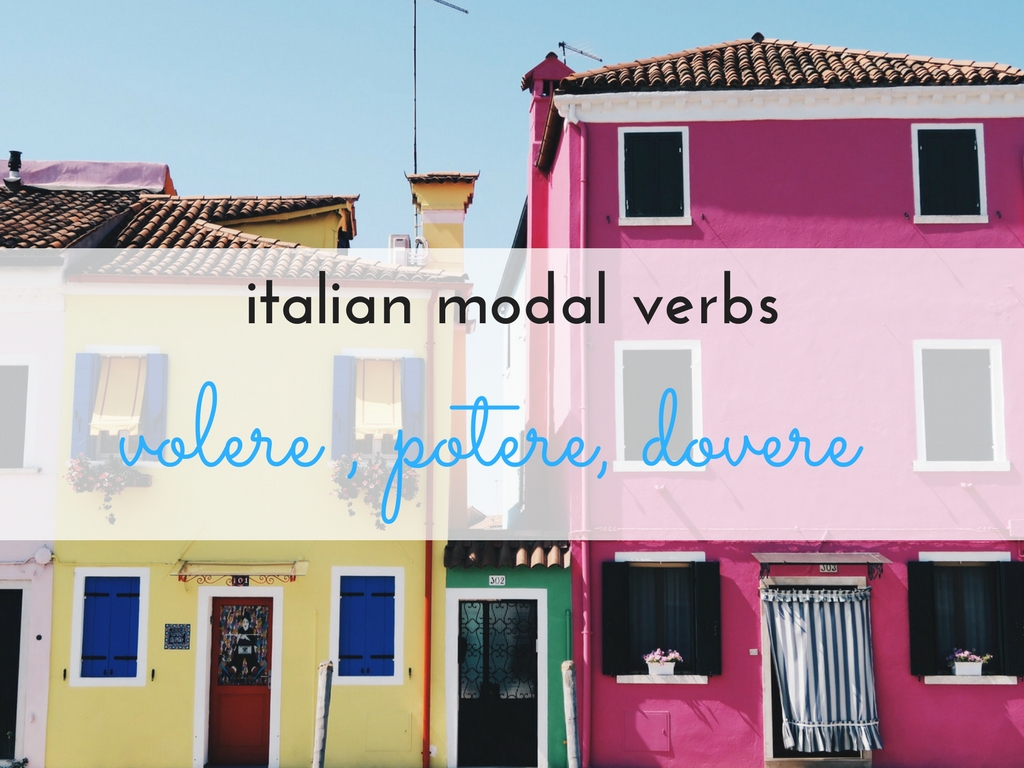Italian Modal Verbs
What’s the Difference Between the Italian Modal Verbs and Other Types of Verbs?
When your teacher (or your book) is telling you “this is a modal verb,” there’s no need to panic! Saying a verb a is “modal” is just a label to remind you that, in Italian, there are three (modal) verbs that have a lot in common and are kind of different from the other verbs.
Voglio – I want
Posso – I can
Devo – I have to, I need, I must
What do they have in common? Simple. They are followed by infinitive verbs (e.g. non conjugated verbs)
An infinitive verb is a base form of any verb, the way you look it up in a dictionary.
So, we can say that modal verbs are always followed by infinitive verbs.
- Voglio vivere in Italia – I want to live in Italy
- Posso aprire la porta? – Can I open the window?
- Devo andare – I must go or I need to go or I have to go
A common mistake made by beginner Italian learners is to use a conjugated verb after a modal verb, such as in the incorrect phrase “Voglio vado = I want I go,” which should be corrected to “Voglio andare”. The correct way to say “I want to go” in Italian, is by using the infinitive form of the verb “andare” after the modal verb “voglio”.
How to Conjugate Volere / Potere / Dovere in the Present Tense?
The Italian modal verbs dovere, potere, and volere express necessity, possibility, and desire, respectively. They are also used to request permission, make requests, and offer assistance. Modal verbs are always followed by an infinitive and are irregular, so they need to be memorized. Since they are high-frequency verbs, it’s crucial to know their conjugations.
Conjugation of the modal verbs in the present tense
| VOLERE (want, wish) | POTERE (can, may) | DOVERE (need, have to, must) |
|---|---|---|
| io voglio tu vuoi lui/lei vuole noi vogliamo voi volete loro vogliono | io posso tu puoi lui/lei può noi possiamo voi potete loro possono | io devo tu devi lui/lei deve noi dobbiamo voi dovete loro devono |
Examples:
- Voglio andare al supermercato (modal verb + infinitive + object) – I want to go to the grocery store.
- Devo comprare della cioccolata (modal verb + infinitive + object) – I need to buy some chocolate.
- Non posso aspettarti (modal verb + infinitive ) – I can’t wait for you.
Let’s see now how to use the Italian modal verbs in-depth…
The Verb ‘Volere’
Volere: to want, to wish
- Voglio mangiare giapponese – I want to eat Japanese
- Voglio il sushi e la tempura – I want sushi and tempura
The Verb ‘Dovere’
Dovere + infinitive: must, to have to, to need to
- Devo andare in palestra – I must (need, have to) go to the gym.
Dovere is a common Italian verb that has three possible translations into English:
- I must
- I have to
- I need to
English vs. Italian
In English, “I must” and “I need to” have different meanings. However, Italian does not make this distinction. To express the obligation implied by “must” in English, the only option in Italian is to pronounce “devo” more emphatically.
- Devo studiare – I need to study
- DEVO studiare – I must study
So, remember that there’s no formal difference between “I must,” “I need,” and “I have to” in Italian. They can all be translated with the verb dovere.
Dovere can also be used as a non-modal verb with a different meaning than its modal form. When used as a non-modal verb, “dovere” is followed by a noun instead of an infinitive verb. In this case, “dovere” means “to owe”
Dovere + noun: to owe
- Ti devo 5 euro per la piazza – I owe you 5 euros for the pizza

Test Your Italian
Not sure what your Italian level is? I’ve created a free online Italian test to help you determine it.The Verb ‘Potere’
Potere means “can or may” when asking for permission or being allowed (or not allowed) to do something.
- Posso uscire un momento? – Can I leave for a second?
- I bambini non possono guardare la tv di sera tardi – Children are not allowed to watch TV late.
English vs. Italian [sapere vs. potere]
Potere does not express the ability to do something, as it does in English.
To express the ability to do something in Italian, you should use the verb “sapere” which means “to know how to” or “to be able to”.
Examples:
Chart 1: Possibility/Permission
| Io posso parlare italiano | “I am allowed to speak Italian” or “I might be able to speak Italian” |
| Posso cantare | “I’m allowed to sing” |
Chart 2: Ability/Knowledge
| Io so parlare italiano | “I can speak Italian” or “I know how to speak Italian” |
| So cantare | “I can sing” or “I know how to sing” |
Avoid the common mistake of using potere in these types of sentences. If you ask someone “puoi cucinare?” – you are actually requesting him or her to cook.
- Puoi cucinare? – Will you cook? (I want you to cook)
- Sai cucinare? – Can you cook? (Do you know how to cook?)
Modal Verbs with the Passato Prossimo
Conjugating modal verbs with the passato prossimo (and other compound tenses*) needs a special construction.
A compound tense is a verb resulting from the combination of an auxiliary verb and a past participle (e.g. past conditional, compound future, past perfect, etc..)
How to Conjugate an VOLERE / POTERE / DOVERE in Passato Prossimo?
If you have already learned the passato prossimo (the main past tense in Italian), you know that it’s a combination of an auxiliary and a past participle (e.g. ho parlato = I spoke, I’ve spoken).
But, what’s the correct auxiliary to use with modal verbs in the passato prossimo?
When using a modal verb in the past tense, the correct auxiliary to use depends on the main verb that follows the modal verb. In general, both “essere” and “avere” can be used as auxiliary verbs with modal verbs in the passato prossimo.
The auxiliary verb used depends on the main verb that follows the modal verb.
If the main verb is transitive and takes a direct object, such as “mangiare” (to eat), the auxiliary verb used will be “avere”. If the main verb is intransitive and does not take a direct object, such as “andare” (to go), the auxiliary verb used will be “essere”.
| Italian | English | Auxiliary Verb |
|---|---|---|
| Ho voluto mangiare | I wanted to eat | Avere |
| Ho dovuto mangiare | I had to eat | Avere |
| Ho potuto mangiare | I could eat | Avere |
| Sono voluta andare | I wanted to go | Essere |
| Sono dovuta andare | I had to go | Essere |
| Ho potuto andare | I could go | Avere |
Note that when the auxiliary verb preceding the modal verb is ‘essere’, the past participle of the modal verb agrees in gender and number with the subject of the sentence.
| Sono dovuta andare via | I had to leave (dovuta, feminine singular) |
| Ci siamo alzati tardi | We got up late (alzati, masculine plural) |
| Non siamo potuti venire | We could not come (potuti, masculine plural) |
Let’s recap:
There are three modal verbs in Italian.
They are volere, potere, and dovere. And we call them modal verbsto remind us that they are different from the majority of other verbs in Italian, because:
- they are irregular.
- they are always followed by an infinitive verb.
- they can use both essere and avere as auxiliaries in compound tenses, like the passato prossimo
- when they come in conjunction with a pronoun, the pronoun can either precede the modal verb or be joined onto the end of the infinite that follow the modal verb.
Imperfetto of modals verbs
If this is easy for you, you might be interested in learning about the difference of usage of the modal verbs between the passato prossimo and the imperfetto.
How to Use the Modal Verbs with the Pronouns
This is more advanced topic, if you are a beginner Italian learner, you can skip it for now.
Modal verbs in Italian allow for the position of pronouns to be flexible. In Italian, a pronoun usually comes before the verb, unlike in English where it comes after. However, with modal verbs, the pronoun can come before the modal verb or after the infinitive verb that follows the modal verb. For example:
| Voglio comprarlo | I want to buy it [pronoun ATTACHED ONTO the infinitive] |
| Lo voglio comprare | I want to buy it [pronoun BEFORE the modal verb] |
Both structures are interchangeable and commonly used in spoken Italian.
If you don’t understand well the idea of pronouns in Italian, I encourage you to visit this page: The Italian Direct Pronouns








